Picto Diary - 19, 20 September 2017 - PANAMA CANAL
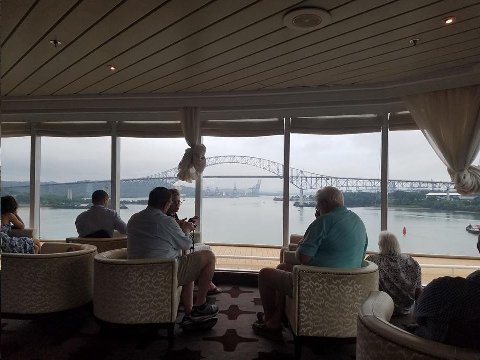
Above: Bridge of the Americas. Panama Canal. 20 September 2017.
Image taken from Observation Lounge. Regent Seven Seas Mariner.
The ship took on the pilot about 5:30 AM. I reached the lounge at 6:00 AM, getting up their, hopping with the aid of the walker, on my own power. The whole trip took about 125 hops... down the companionway, into the elevator vestibule, up the elevator, one floor, then into the lounge.
I was surprised to see so many people already in the lounge. But, I found a pretty good seat. TIMDT joined me at 7:00 AM. We stayed in the lounge for over three hours as we passed through the Miraflores Locks and the Pedro Miguel Locks.
My excitement was palpable as the Bridge of the Americas emerged from the morning mists.
Here I was about to enter what many consider to be the greatest engineering accomplishment in history.
Completed in 1914, on the eve of WWI, the canal took eleven years to build. The French had tried, in the same location, to build a canal twenty years previously, but failed largely due to tropical diseases decimating their work force. 20K people died in the French attempt to build the Panama Canal.
Goaded and prodded by US President Teddy Roosevelt, in 1903, American interests purchased the canal rights from the French on the cheap and then petitioned the Panamanians for permission to resume the massive building project.
The Panamanians were OK with going ahead, but, then, they were part of a Columbian federation and the Columbians voted down the American offer.
Not taking no for an answer, the Americans supported (engineered?) a successful Panamanian independence movement, even sending warships to Panama to thwart Columbian troop movements north.
The US negotiated a bullet proof treaty with Panama which ceded the Americans, in perpetuity, with sovereign rights to land ten miles on either side of the length of the entire canal. This area became known as the Panama Canal Zone.
The Panamanian isthmus was too high and rocky for the original French and later American builders to clear a sea-level passage like the Suez Canal, so ships have to be lifted 85 feet from the Pacific to enter the lake midway through the canal, and lowered again on the Atlantic side.
Learning from the failed French attempt to build the canal, the American Army Corps of Engineers managed to control the spread of disease among contract workers of whom almost 20K came from Barbados. US engineers built a railway, imported giant steam shovels and moved mountains to complete an engineering wonder of the world.
The canal opened for business in 1914. By 2011, one million ships had passed through the canal.
In 1977, US president Jimmy Carter negotiated a treaty with President Torrejos of Panama to cede all canal rights to Panama by 1999.
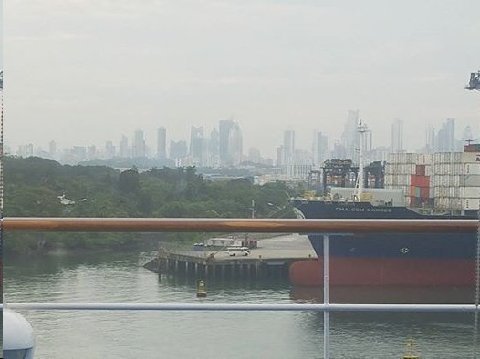
Above: Panama City, Panama. 20 September 2017.
The Panama Canal generates annual revenues of $1.2 billion. The canal buttresses a robust service economy, including financial services and ship servicing. Panama GDP is about $50 billion.
Last year, a ten year project designed to double the canal's capacity - and revenue - was completed. New locks were installed that can handle Panamax container ships.
The original project was budgeted at $5 billion. The Spanish led contractor consortium went over budget by double that and financial claims being made by the contractor against the Panama Canal Authority (PCA) are currently in arbitration.
There are concerns, also, about the overall quality of the construction. The PCA claims that porous concrete used by the contractor is already deteriorating.
Tug operators complain that the new tugs purchased to handle the big Panamax ships are flawed. The tug operators say they only work effectively in reverse.
Throughput in the new locks is well below capacity as canal operators find themselves on a steep learning curve to master techniques to handle the much bigger ships.
While the PCA claims that they will make the new canal work, there appear to be many "ifs" about their ability to realize original expectations.
The US and China are the top users of the Canal. In 2014, Panama completed a metro system in Panama City, valued at $1.2 billion. Strong economic performance has not translated into broadly shared prosperity, as Panama has the second worst income distribution in Latin America. About one-fourth of the population lives in poverty; however, from 2006 to 2012 poverty was reduced by 10 percentage points.
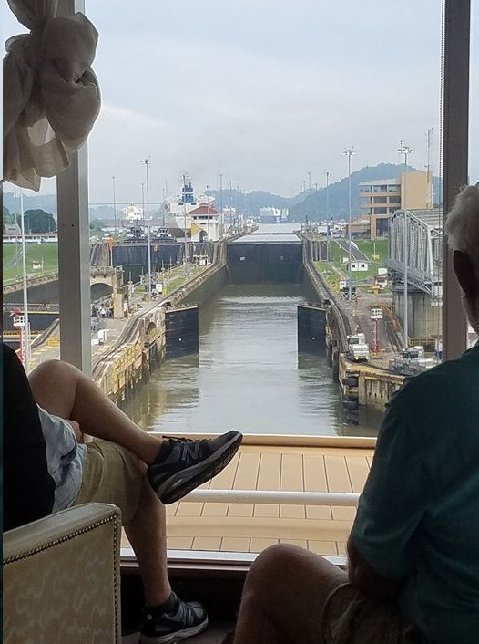
Above: Miraflores Locks. Panama Canal. 20 September 2017.
Image taken by Bishop from observation lounge of Regent Seven Seas Mariner.
Coming from the Pacific, we must go through two sets of locks, one (Miraflores) with two 27 foot raises, and the other (Pedro Miguel), one mile further, with one 27 foot rise.
After passing through the two sets of locks, our ship will pass through the Calebra Cut and cross Gabun Lake to the Gabun Locks.
At Gabun Locks, in three successive locks we'll be lowered back down to sea level eight miles away by canal from the Caribbean Sea.
Total distance: 50 miles. Time of passage: Eight to ten hours.
The locks are filled by gravity. The only power required is for the "mules" which pull and stabilize the ships when they are in the locks and for electric power to open and close the lock gates.
For the canal to be able to operate at full capacity, there must be enough water to accommodate the draft of the large ships. During occasional drought conditions, the lowering lake reduces the draft space and some boats are unable to make it through the canal. Under such drought conditions, the PCA authority advises shippers to lighten loads.
During the last two years there has been plenty of rain and the ships passing through the canal are able to do so at full load capacity.
Dredging, to alleviate draft problems, goes on constantly. Charges are buried into the mud at the base of the canal. The exploding charges create loose mud at the canal bottom which is then removed by dredging equipment.
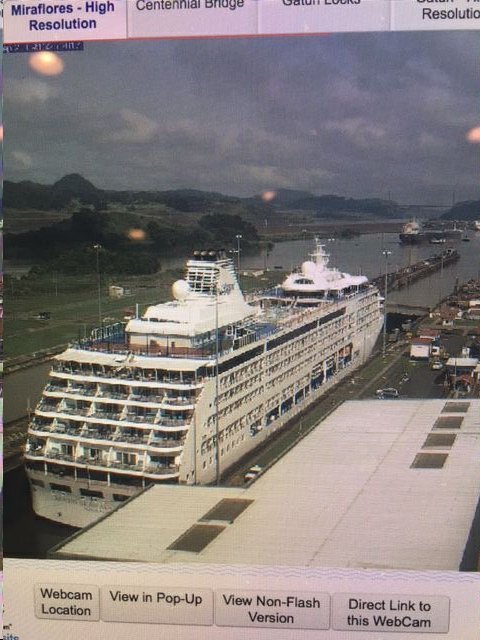
Above: Regent Seven Seas Mariner in Miraflores Locks. 20 September 2017.
Image was captured by Portland, our daughter in law, from the PCA website video cam at the time of the ship's passage.
TIMDT and Mwah (sic) are sitting in the forward top deck observation lounge at the time this image was captured.
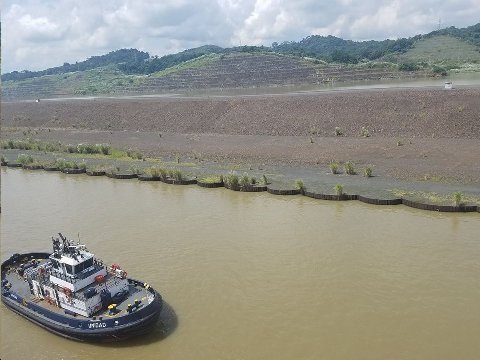
Above: Tug. Nearing Pedro Miguel Locks. Panama Canal. 20 September 2017.
Beyond tug, note higher water level of the new Panamax waterway inaugurated last year.
Pacific to Caribbean bound Panamax ships (read humongous 1000 container ships, fare $1MM per passage), are raised to the level of Gatun Lake at new Miraflores Locks, part of the Panama Canal Expansion Program, inaugurated in 2016.
Our ship, N 21 Zulu, was only raised 2/3 of the way to Gatun Lake level while passing through Miraflores Locks. Hence, our need to get up the third level at upcoming Pedro Miguel Locks about a mile a way through the small Miraflores lake.
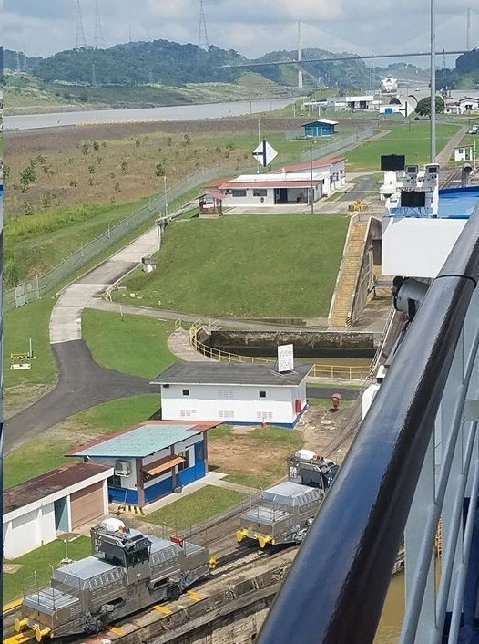
Above: Pedro Miguel Locks. Panama Canal. 20 September 2017.
From our 11th deck cabin deck.
Gatun Lake level Panamax ship passage at left. Pedro Miguel Locks will take us up 27 feet to Panamax passage/Gatun Lake level, a high level for Panama Canal of over 80 feet above sea level.
Note "mules" lower left. Six of these 300 hp tractors, three on each side, will pull N 21 Zulu, our ship, through the lock.
Centennial bridge, beyond, after which, not seen in image, Culebra Cut and Gatun Lake.
Note also port bridge extension (blue floor), one deck below us, forward.
Hard to get a grip on the fact that from the Pacific to the Caribbean, the Panama Canal goes from southeast to northwest!
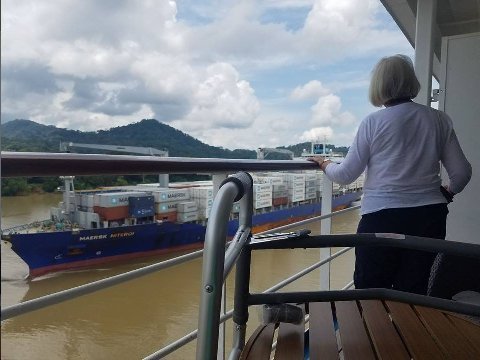
Above: TIMDT observes ship moving opposite direction, Gatun Lake. Panama Canal. 20 September 2017.
Image captured from our 11th deck cabin balcony. Regent Seven Seas Mariner.
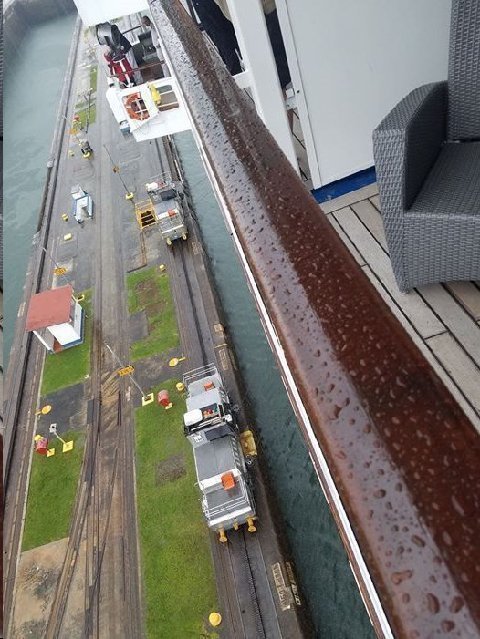
Above: Gatun Locks. Panama Canal. 20 September 2017.
Mules pulling and stabilizing ship.
Three chambers...27 foot lowering, each chamber.
On our way out to Caribbean Sea. — at Gatun Locks Panama Canal.
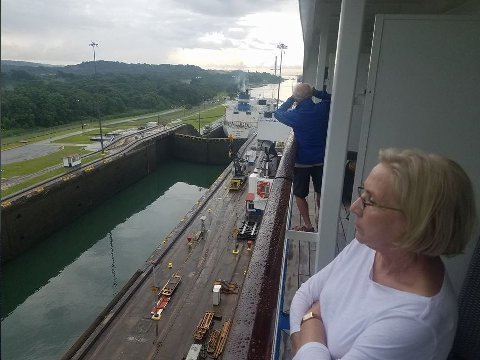
Above: Montage (on adjacent forward deck) and TIMDT. Gatun Locks. Panama Canal. 20 September 2017.
N 21 Zulu is in second of three Gatun lock chambers.
One more chamber, 27 foot drop, before we reach sea level.
Ship beyond is in parallel channel, next lock, going in same direction.
Then....Caribbean Sea and on to Cartagena. — at Gatun Locks Panama Canal.
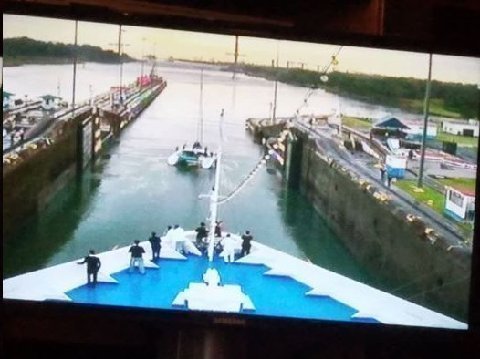
Above: Gatun Locks. Panama Canal. 20 September 2017.
Regent Seven Seas Mariner.
Ship's closed circuit TV in our cabin.
Leaving last Gatun lock at sea level.
Note the catamaran which was in the lock with us.
Now, eight mile long channel to Caribbean Sea. — at Gatun Locks Panama Canal.
I was awe struck for the entire day of passing through the Panama Canal. As we passed through the Panama Canal, I tried, and failed, to comprehend the capacity and vision of the planners of this great engineering accomplishment.
Panama Canal Chief Engineer was John Frank Stevens.
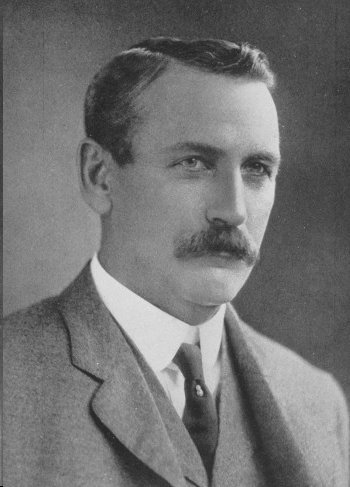
Above: John Frank Stevens. Chief Engineer, Panama Canal construction.
How is it that Stevens is not venerated as a hero of some sorts? Why have the names the great engineers who have established the framework for modern society not been brought top of mind to those of us who have benefited from their creations?
I was reminded of other great engineering sites that I had recently seen.
In 2010 I rode a motorcycle from Anchorage to Prudhoe Bay and back. For much of that route, along "the Haul Road," we followed the Alaska Pipeline, another great engineering accomplishment.
I remember reading a story board at the BLM exhibit at the Yukon crossing of the Haul Road. There was a weathered description of the chief engineer of the Alaska Pipeline, whose name was Edward L. Patton. If I mentioned the name of Ed Patten to one thousand Americans, none would be able to identify him.
Last October, Hoops and I visited the New York Subway Museum in Brooklyn, NY. Another great engineering story.
It rankles that our society, driven by modern media, seems to celebrate the trivial and ignore the substantial... like the engineers who realized these great projects.
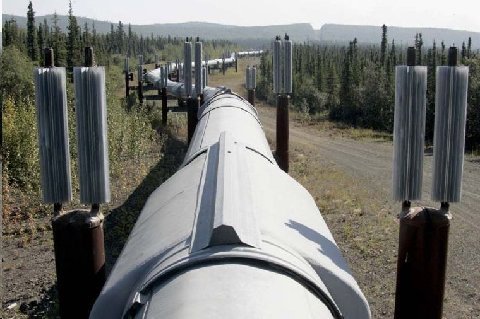
Above: Trans Alaska Pipeline.
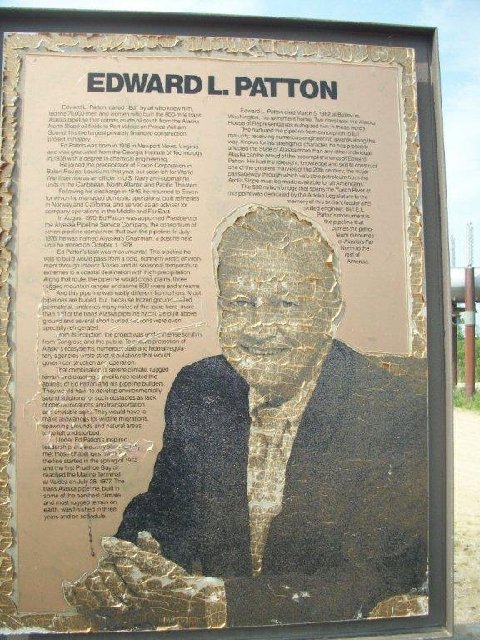
Above: Edward L. Patton. Chief Engineer. Trans Alaska Pipeline.
Storyboard at BLM Exhibit. Haul Road and Yukon River. 2010.
Addendum:
Second canal will lose money I doubt it will be built.
Burning Man,
Reno, NV
Steve
Margaret looks wonderful. Give her my best..
The Pope,
Naples, FL
Not the voyager. The mariner is name of ship.
TIMDT,
Regent Seven Seas Mariner